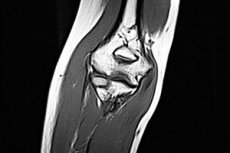MRI of the elbow joint
Last reviewed: 23.04.2024

All iLive content is medically reviewed or fact checked to ensure as much factual accuracy as possible.
We have strict sourcing guidelines and only link to reputable media sites, academic research institutions and, whenever possible, medically peer reviewed studies. Note that the numbers in parentheses ([1], [2], etc.) are clickable links to these studies.
If you feel that any of our content is inaccurate, out-of-date, or otherwise questionable, please select it and press Ctrl + Enter.

Indications for the procedure
Indications for magnetic resonance imaging include trauma, as well as inflammatory and dystrophic diseases of this joint, accompanied by pain and mobility restriction.
It is difficult to overestimate the role of high contrast images and detailed visualization of the structures of the elbow joint with the help of MRI, because it is complex - from three simple joints (block-shaped pleuraloid, globose, brachial and cylindrical radiolucent) that connect three bones in a joint joint bag.
Since it is the MRI of the elbow joint that gives the most complete information on its condition, this makes this method the main tool for conducting differential diagnosis. In addition, such examination is necessary before surgical intervention - osteosynthesis, arthroplasty or endoprosthetics, as well as to evaluate their results.
What the MRI of the elbow joint shows is the articular surfaces of the joints forming the joint and the cartilage covering them, the condyles and epicondies, the joint bag and its synovial membrane, ligaments, tendons, surrounding soft tissue joints, blood vessels and nerves-minimizes the risks of a wrong diagnosis.
Due to the layer-by-layer 3D reconstruction of the image of all internal joint structures, the MRT anatomy of the elbow joint of a particular patient is determined. The specialist compares it with images in electronic atlases of normal MRI sections and identifies deviations.
Based on the analysis of these abnormalities diagnose:
- fractures of the elbow process, coronary process of the ulna, cervix and the head of the radial with rotational displacement, fragmentation, fragments, rupture of ligaments;
- inflammation of the elbow joint (arthritis), its joint capsule (bursitis) or synovium (tenosynovitis);
- dystrophy of articular cartilage and development of arthrosis (osteoarthrosis);
- inflammation of the periosteum, tendons and ligaments in the epicondyle of the humerus - epicondylitis of the elbow joint;
- tunnel syndrome of the elbow joint (cubital tunnel syndrome).
MRI reveals the presence in the joint and surrounding tissues of post-traumatic, periosteal or degenerative-dystrophic osteophytes (bone growths).
Technique MRI of the elbow joint
If the examination is carried out on a closed tunnel type scanner, the patient lies on his back (or on the stomach), stretching his arm. When the tomograph is open (without the tunnel chamber), the examination passes by sitting.
But in any case, the limb stitching with MRI of the elbow joint is performed according to the guidelines for scanning parameters and patient placement technique - with fixation of the head and limbs to ensure complete immobility.
MRI scan of one elbow joint can last from 15 to 25 minutes.
Contraindications to the procedure
It is contraindicated to conduct an MRI examination of the elbow joint (and MRI scan in general) if the patient is implanted with an artificial pacemaker (pacemaker), an insulin pump or there are cochlear implants, metal dental crowns and prostheses, stents and vascular clips, intraosseous pins, etc. .
Do not perform an MRI with claustrophobia and during the first trimester of pregnancy.
For tomographs of tunnel type, the body weight of patients is limited to 120-130 kg.
Complications after the procedure
In some cases - with a higher EMF voltage of powerful scanners or violations of the protocol of examination for its duration - complications may occur after the procedure in the form of a fast dizziness, the appearance in the mouth of a metallic taste or involuntary jerking of individual muscles.
As evidenced by the reviews of most patients, MRI of the joints did not affect their state of health and made it possible to identify the exact cause of problems with the elbow joint.


 [
[